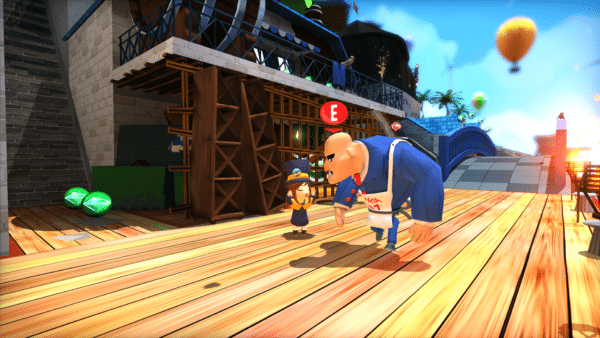Red Stewart reviews A Hat in Time…
When the Nintendo 64 launched onto the scene in 1996, it needed a unique library to compete with the strong success of the PlayStation 1, which had come out a year before. That resulted in the Nintendo team developing Super Mario 64, a video game that came packed as a launch title for the console. With a gorgeous 3D environment, brightly colored polygons, intuitive controls, and well-designed giant worlds to explore, it became a staple of game design as a whole.
Though released over 20 years later, Gears for Breakfast’s A Hat in Time is a clear homage to this style of gameplay that made an impact on us all those years ago. It walks a fine line between over-indulging in nostalgia and forging its own path, creating an interesting experience that has its tiring moments. But is this a suitable release in today’s age of open world environments and action-RPGs, or does it fall prey to the same rose-tinted flaws that plagued Yooka-Laylee? Let’s take a look.
Like most 90s platformers, A Hat in Time does not focus much on a deep story, instead investing most of its effort on the gameplay elements. But what is there is satisfactory enough. You play as the Hat Kid, a young girl traveling back to her home world via a spaceship. During the journey, though, a member of the local galactic mafia attacks the ship, sending its fuel cells, dubbed “Time Pieces,” all over the planetary system, and forcing Hat Kid to retrieve them.
There are some twists and turns that help shake up things, and there is even a degree of self-awareness present in the writing that makes for some humorous scenarios. However the general gist of things is that you’re given a MacGuffin and told to find it across a vast expanse of land. The question then becomes is this land worth visiting?
To describe the art style of A Hat in Time would be a difficult task as it falls somewhere in between photorealism and a cell-shaded scheme. Character models are appropriately portioned with angular faces and bent limbs, but also possess a cartoony flair about them that gives them an eye-popping quality.
This trait extends to the different areas you will explore in your quest for the Time Pieces. Buildings may have realistic architectural features like buttresses, glass windows, and brick walls, but there is always something about them that will assure players that they are not in real city, like crazy colors, sleek surfaces, and that unique pigment provided by cell-shading.
For the most part, the game runs very well, and that is genuinely saying something considering the amount of parkour-esque free running you have to do to traverse the intricately made settings. However, there are two exceptions where the frame rate drops. One is during cutscenes and the second is during the loading screen when you are returning from a world back to the spaceship. Nothing major to be concerned about, but just keep it in mind.
The sound design in A Hat in Time is top-notch to say the least. Like the games it draws inspiration from, the audio is built around three basic functions: giving each level a distinct theme, emphasizing character SFX, and providing a degree of voice acting for the cast.
The music for the levels is nicely integrated, enough in the background to not dominate the soundscape but also present enough that you can make a distinction between the worlds. The best part is, if you don’t like a particular tune, A Hat in Time provides the option to switch out the level music, with certain tracks being unlocked behind a roulette-style minigame.
The sound effects are good as well: water splashes when you fall into it, enemies grunt out in pain when you strike them, and balloons pop when you jump on them amongst a plethora of appropriately enjoyable noises.
Unfortunately, when it comes to the voice acting, A Hat in Time falters to an extent. The voice artists themselves are fine, but since they are playing one-dimensional characters, they essentially use the same tone of voice whenever they speak, which I personally found grating enough to the point that I was reading through the dialogue as fast as I could to skip past the vocal performance.
As I mentioned earlier, A Hat in Time incorporates aspects of free running into its 3D platforming mechanics. There are walls you can jump off of, tightropes you can walk on, and even grappling hooks you can swing across, all of which add up to a smooth fast-paced experience. In a lot of ways, it feels like a mix between Super Mario Sunshine and Sunset Overdrive in terms of the lightning movement.
A Hat in Time’s gameplay features typical platforming elements like double jumps and short momentum bursts to encourage city traversal, but it also comes with some gimmicks to help separate it from similar releases. First and foremost are the titular hats. There are six of them in total, and need to be crafted if you want to get all the abilities associated with them, such as super speed and time stopping. A quick interface similar to the weapons menu in Assassin’s Creed IV: Black Flag allows you to switch between the hats easily so you don’t have to worry about a Water Temple iron boots-type annoyance from occurring. While all are not required to beat the game, if you are a fan of 100 percenting things like myself, you will need them in order to revisit past levels, thereby giving A Hat in Time significant replay value.
Badges can be bought through the in-game currency of “pons” in order to provide you with further powers to help with your journey, like a magnet that attract items and a last-minute parachute that saves you from taking damage from high falls.
Overall, there is enough variety to keep things spiced up, but it should be noted that going through these worlds and fighting the same enemies over and over again can honestly get tiring. Sure there are times when the levels themselves are changed in configuration, like when Mafia World is flooded with lava, but you are still going to have to take down the same exact grunts in the same exact manner. So keep in mind that repetition is a problem in spite of the gameplay changes.
A Hat in Time arrives on the PlayStation 4 over a month after Super Mario Odyssey released on the Nintendo Switch. It is a game that is clearly targeted towards people who grew up playing Rare platformers, but, at the same time, does try to be its own thing. There will be unfavorable comparisons to other releases, and the $30 asking price might be too much for a game that will most likely only provide 10 hours of gameplay to casual players. But it is very fun, and it is always worth supporting these independent studios trying to make it big in the video game industry. Base your decision on those factors.
Pros:
- Easy to get into for gamers of all experience levels
- Very fun worlds with some very fun objectives
- Unlockable skins for your hats and clothes in-game reminds us of the good old days before DLC and microtransactions.
Cons:
- While not featuring the annoying sounds presents in Yooka-Laylee and past Zeldas, the Hat Kid will occasionally make this weird noise which I assume is them sticking their tongue out.
- Some very dark humor finds itself into the script, going against the otherwise kid-friendly nature of the game.
- The inability to mark your map makes memorization of locations pertinent.
Rating: 8/10
Reviewed on PS4.
Red Stewart

















